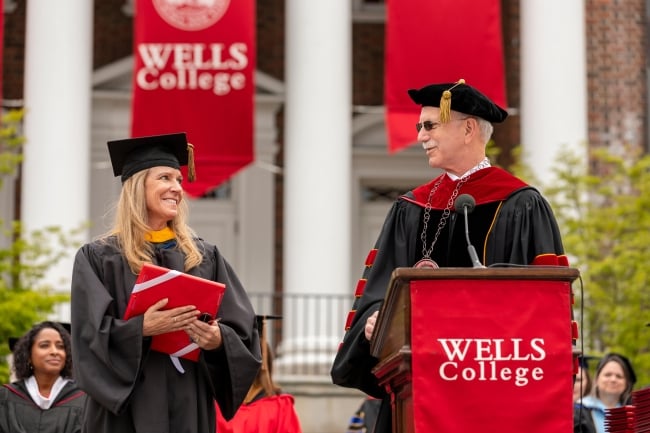You have /5 articles left.
Sign up for a free account or log in.

Wells College president Jonathan Gibralter used ChatGPT to craft a commencement-day speech that he supplemented with his own remarks about forging human connections.
Wells College
As Wells College graduates gathered last month, President Jonathan Gibralter delivered a commencement address that sounded like countless others delivered across the country. It hit the usual themes: be prepared for challenges and setbacks, cultivate perseverance, and embrace opportunities.
But his speech culminated with a twist.
“Before I end this address, I wanted to let you know that everything I just said to you was written by artificial intelligence. I asked ChatGPT to write a commencement address from the president of Wells College to the graduates,” Gibralter revealed to a surprised audience.
“Why did I do that, and why am I telling you this? Because the world you are graduating into is changing very rapidly, and you have in front of you a world where electric vehicles will replace those powered by fossil fuels, a world where chat bots can replace the need for intellectual curiosity, a world in which some people reflect on their lives by the number of people who are connected to them on social media, a world where people may soon live in the metaverse, and the list goes on and on,” Gibralter told students, challenging them to stay intellectually curious.
Making the Point
In an interview with Inside Higher Ed, Gibralter said he had been reflecting on ChatGPT when he sat down to write his commencement address and became curious about what the program might propose. The speech generated by the artificial intelligence tool was fine over all, Gibralter said, but it lacked “the heartfelt message that I wanted to convey to our graduates.”
The president then crafted a message about thinking critically, reasoning wisely and acting humanely—drawing from the college’s mission statement. Above all, he encouraged graduates to pursue and cherish human connection.
“As you leave Wells College, remember that the connections I hope you will always seek out will be with other people in person and not with chat bots or social media sites or in the metaverse. You all have an opportunity to create your own path in this life and, the most meaningful path will be the path you take in relation to other people in your lives,” Gibralter said.
Over all, Gibralter sought to emphasize the importance of forging human connections—and the value of a liberal arts education—in an increasingly technologically driven world.
Gibralter wasn’t the only college president to tap ChatGPT for a commencement speech this season.
Northeastern University president Joseph Aoun asked ChatGPT to provide a list of top five commencement clichés. The program offered “Follow your dreams; you can make a difference in the world; believe in yourself; don’t be afraid to take risks; [and] never give up on your goals.”
Aoun shared that detail in his commencement speech last month and offered his own lessons: “Opportunity is always in motion, machines don’t weep [and] get out of your TikTok tunnel.”
At Michigan State University, Prabu David—who serves as vice provost for faculty and academic staff development and in various other roles—also asked ChatGPT to contribute to his speech for a College of Communication Arts and Sciences commencement ceremony last month.
In the speech, David discussed his experience with ChatGPT and noted that it struggled with his prompts at times but also delivered most of the necessary ingredients for a commencement address, including some standard clichés. The overarching theme was focused on treating people with grace, and David ultimately concluded his speech with a verse from the Bible that ChatGPT offered up: “Let your conversations be full of grace, seasoned with salt.”
Other AI Experiments
That college leaders are using ChatGPT in commencement speeches even as many in the higher ed world fret about its potential for abuse reflects the mix of promise and uncertainty that surrounds the rapidly evolving technology.
Much of the attention on generative AI has focused on student usage and the risk of misuse. Concerns about academic dishonesty have roiled higher education since ChatGPT, one of the most popular AI tools, launched last fall. Many academics have decried the way students have leveraged ChatGPT to write papers rather than do the work themselves.
“I would say the general reaction of the faculty is one of anxiety and uncertainty,” Gibralter said.
But for all the fear of students taking advantage of AI, college leaders are also intrigued by its untapped potential and are using Chat GPT and other tools to accomplish various tasks. Some colleges have experimented in headline-making ways.
Following a shooting at Michigan State University in February, Vanderbilt University’s Peabody Office of Equity, Diversity and Inclusion emailed a statement to campus constituents written entirely by ChatGPT, as noted above the signature line. After the email generated outrage, Vanderbilt quickly apologized.
Southern New Hampshire University has also experimented with ChatGPT, using the tool to help create a content module for a phlebotomy class. It also asked the AI tool to write the script for a 30-second commercial advertising the institution and develop the shot selection. In both instances, AI tools showed promise, SNHU president Paul LeBlanc wrote in an opinion piece for Inside Higher Ed in March. He argued at the time that the higher ed sector needed to get ahead of a coming paradigm shift.
Numerous institutions, including Harvard University and the Georgia Institute of Technology, are exploring how to leverage AI tools as virtual teaching assistants in certain courses.
And some college leaders are experimenting with ChatGPT on personal projects.
Mike Magee, president of Minerva University, recently told Inside Higher Ed that he has considered the uses for ChatGPT while writing a book about academic policy. Working on a chapter that delves into game theory, Magee said he plugged several paragraphs into the program and asked it to rewrite them in the fashion of a game theory scholar. He was amazed as he watched the tool quickly transform his work into paragraphs reflecting high-level game theory discourse.
But Magee is unsure whether he will use those modifications in the book, he said, and he is still grappling with the nascent technology. He noted it raises thorny questions about authorship and ethics.
The Looming Potential of AI
Stephen Monroe, department chair and professor of writing and rhetoric at the University of Mississippi, told Inside Higher Ed that higher education is facing a new reality.
“Those of us in the liberal arts—and in higher education generally—are now stakeholders, like it or not, alongside the frenetic developers of Silicon Valley,” Monroe wrote in an email. “We need to think carefully about preparing our students to use Generative AI ethically and effectively. We need to update our pedagogies, but we also need to remember that human meaning is generated by human writers. AI can assist in that process, but it cannot substitute.”
The use of artificial intelligence in higher education applications isn’t new; chat bots, for example, are commonplace on college websites and able to answer basic questions on admissions, financial aid and other topics. But oftentimes those functions come with certain limitations. However, experts believe that leveraging AI as it continues to improve will not only enhance the quality of current offerings, such as chat bots, but also introduce new tools that institutions can deploy.
Ron Yanosky, director of the research advisory services team at the consulting firm EAB, noted that higher education has viewed ChatGPT with “a combination of anxiety and hostility.” Many faculty and administrators did not recognize its potential at first or were heavily focused on how it could be misused.
Despite the ongoing panic around potential abuse, which prompted a flood of statements from university officials addressing ChatGPT and academic dishonesty in the last school year, Yanosky believes the sector is increasingly open-minded about how to leverage such tools.
He encouraged college leaders to create high-level task forces to focus on the implementation of ChatGPT and other AI, noting the vast potential for such tools in data analysis, tutoring services, improved chat-bot functionality and new areas that have not been explored.
The conversation around AI, Yanosky noted, is only beginning. And the products themselves are still maturing, which means there will likely be significant trial and error and occasional missteps as users look to implement them.
“There are going to be some gray areas here,” Yanosky said. “Somebody’s going to find out what is not considered appropriate by making a mistake and not realizing other people’s perceptions.”
Higher education is often criticized as a sector that is slow to change, akin to turning a freighter. Gibralter recalled concerns about distance education years ago when it consisted of sending videotapes through the mail, which some believed would lead to the downfall of institutions. He’s generally been on the side of innovation, he said, but he has been alarmed by the rise of tools like ChatGPT.
“In 37 years in higher education, this one concerns me, because it’s taking an incredible breadth and depth of available information, some of it true, some of it not, and sort of triangulating it. And I hope it doesn’t replace the relevance and importance of human relationship and contact,” Gibralter said.
But now that AI has arrived in full force, he said, universities have to learn to work with rather than resist such tools, given their potential for solutions alongside the new challenges they present.
“I think it’s going to be the responsibility of every institution of higher learning to decide how to balance two somewhat opposing views,” he said. “How can we use it to enhance learning? How can we use it to increase the visibility and availability of context and content for students? But how do we then, at the same time, make sure that students are still engaged in learning?”
Gibralter—like many college presidents—is still looking for the answer to those questions.




